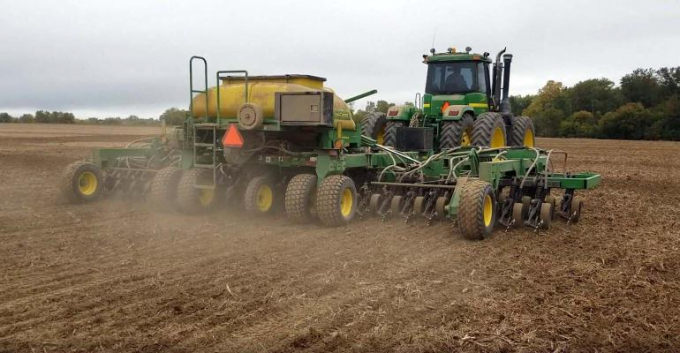June 15, 2025 | 07:06 GMT +7
June 15, 2025 | 07:06 GMT +7
Hotline: 0913.378.918
June 15, 2025 | 07:06 GMT +7
Hotline: 0913.378.918

Planting wheat in a research trial last fall. Photo: FP
With input costs biting away at margins, is it time to put some of your acreage to work making money with two crops in 2022. The profit potential is compelling:
-75 bu. per acre wheat yields X $7 (Jul22 forward contract is $7.42) = $525/acre revenue.
-43 bu. per acre soybean yields X $12 (Nov22 forward contract is $12.46) = $516/acre revenue.
Of course this equation assumes a lot of good things will happen, mainly, that weather or other issues don’t ding yields. But these yield estimates are fairly conservative, even for double crop soybeans.
And prices? Well, you could risk it and hope these prices will still be there next July and fall. Or you can use a simple risk management tool to lock in profit now.
Let’s start with the need to protect those high prices for next year’s harvests of wheat and soybeans. Recent spikes in fertilizer prices added another $10 per acre in corn costs, bringing total price increases to 45% since spring, according to our recent analysis. That’s enough to knock 35 cents per bu. off operating margins for 2022 corn – resulting in more soybeans going in the ground next spring. That higher soy acreage, combined with Brazil adding 2 million more soy acres, could overwhelm the market by next fall.
“Anhydrous is a big issue, maybe as much next fall as this next spring,” says Matt Bennett, a central Illinois grain farmer and market analyst with AgMarket.Net. “That’s driven by a fear in the industry that there is going to be fertilizer shortages. Several countries are talking about energy shortages, and you don’t just pull anhydrous out of the ground; you have to use some energy to make it.
“So, if you’re looking at double the cost of nitrogen, it’s pretty tempting to plant more beans,” says Bennett. “Then you look at what wheat prices are doing now. Wheat followed by beans is quite the performer.”
To be sure, there are still costs associated with planting two crops for 2022 harvest. University of Illinois 2022 crop budgets for Southern Illinois pencil in $137 per acre fertilizer costs for wheat, and $29 per acre for soybean fertilizer. Seed costs will run nearly $50 per acre for each crop.
Still, current futures prices should cause more drills to come out of the machine shed this fall.
“It’s crazy what some people can make, planting wheat followed by beans,” says Bennett. “You can lock in an incredible income.”
One of the simplest things you can do now is write an HTA (hedge-to-arrive) contract for wheat for next July, and also for soybeans for next fall. You hedge that crop without any margin call.
“For a producer who doesn’t want a hedge account, you’ll probably pay 8 to 10 cents a bu. to the elevator to write an HTA on $7.45 wheat,” explains Bennett. “So what? How many times have you been able to lock in $7.35 per bu. wheat when you’re planting? It’s not that often.”
You can also consider an options strategy, says Bennett. “For soybeans you can buy a Nov22 $12 put, sell a $10 put and sell a $14 call, to help finance the purchase of the $12 put,” he says. “Essentially, we’re locking in $12 beans for around 10 cents per bu. cost. That gives some assurance that hey, if the market gets hot and runs up to $14 per bu., I’m still participating in that rally. Yet, you still have a strong floor underneath you.”
AgMarket.net has been recommending clients forward contract 50% of next year’s soybean production – an aggressive stance, to be sure. But to Bennett it’s a no-brainer.
“It is, after all, a futures market, and we have no idea what will happen in South America, but they’re adding 2 million acres of soybeans this year,” he says. “And with fertilizer prices the way they are it looks like there will be a lot of incentives to plant beans next year.
“In the end, $12.60 beans are pretty hard to pass up,” he says. “As a producer how can you go wrong? You have to work pretty hard not to make money at those prices.”
(Farm Progress)

(VAN) Extensive licensing requirements raise concerns about intellectual property theft.

(VAN) As of Friday, a salmonella outbreak linked to a California egg producer had sickened at least 79 people. Of the infected people, 21 hospitalizations were reported, U.S. health officials said.

(VAN) With the war ongoing, many Ukrainian farmers and rural farming families face limited access to their land due to mines and lack the financial resources to purchase needed agricultural inputs.

(VAN) Vikas Rambal has quietly built a $5 billion business empire in manufacturing, property and solar, and catapulted onto the Rich List.

(VAN) Available cropland now at less than five percent, according to latest geospatial assessment from FAO and UNOSAT.

(VAN) Alt Carbon has raised $12 million in a seed round as it plans to scale its carbon dioxide removal work in the South Asian nation.

(VAN) Attempts to bring down the price of the Japanese staple have had little effect amid a cost-of-living crisis.